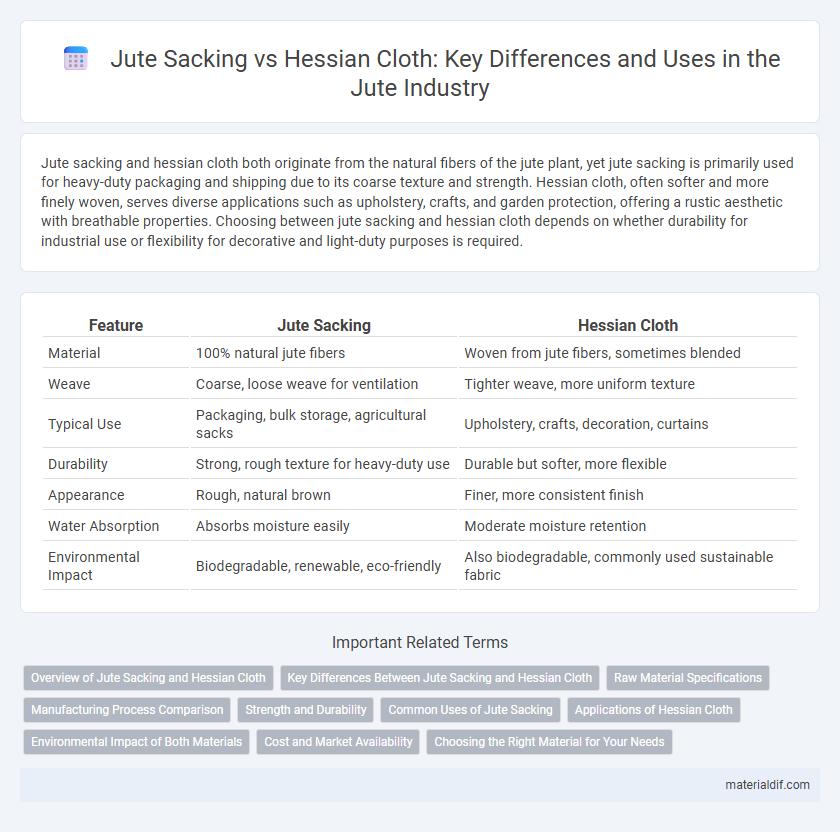Jute sacking and hessian cloth both originate from the natural fibers of the jute plant, yet jute sacking is primarily used for heavy-duty packaging and shipping due to its coarse texture and strength. Hessian cloth, often softer and more finely woven, serves diverse applications such as upholstery, crafts, and garden protection, offering a rustic aesthetic with breathable properties. Choosing between jute sacking and hessian cloth depends on whether durability for industrial use or flexibility for decorative and light-duty purposes is required.
Table of Comparison
| Feature | Jute Sacking | Hessian Cloth |
|---|---|---|
| Material | 100% natural jute fibers | Woven from jute fibers, sometimes blended |
| Weave | Coarse, loose weave for ventilation | Tighter weave, more uniform texture |
| Typical Use | Packaging, bulk storage, agricultural sacks | Upholstery, crafts, decoration, curtains |
| Durability | Strong, rough texture for heavy-duty use | Durable but softer, more flexible |
| Appearance | Rough, natural brown | Finer, more consistent finish |
| Water Absorption | Absorbs moisture easily | Moderate moisture retention |
| Environmental Impact | Biodegradable, renewable, eco-friendly | Also biodegradable, commonly used sustainable fabric |
Overview of Jute Sacking and Hessian Cloth
Jute sacking and Hessian cloth are both crafted from natural jute fibers, known for their strength and durability. Jute sacking typically features a coarser weave, making it ideal for heavy-duty packaging and transportation of goods like grains and potatoes. Hessian cloth, while similar, often has a finer texture and is used in applications such as upholstery, sandbags, and decorative purposes due to its aesthetic appeal and versatility.
Key Differences Between Jute Sacking and Hessian Cloth
Jute sacking is a coarse, durable fabric primarily used for heavy-duty packaging and transporting agricultural products, offering high tensile strength and breathability. Hessian cloth, made from the same jute fiber, features a finer weave and softer texture, making it suitable for upholstery, crafts, and decorative purposes. The key differences lie in their weave density, texture, and intended industrial versus aesthetic applications.
Raw Material Specifications
Jute sacking and hessian cloth are both crafted from natural jute fibers, but differ in raw material specifications based on fiber grade and thickness. Jute sacking utilizes coarse, robust fibers optimized for heavy-duty packaging, offering higher tensile strength and durability. Hessian cloth employs finer, softer jute fibers, prioritizing flexibility and smoother texture for upholstery and decorative uses.
Manufacturing Process Comparison
Jute sacking undergoes a coarse weaving process primarily designed for durability and heavy-duty use, while hessian cloth is woven using finer threads to achieve a softer texture suitable for upholstery and crafts. The manufacturing of jute sacking emphasizes thicker yarns and tighter weaves, enhancing tensile strength and resistance to wear. Hessian cloth production involves careful bleaching and finishing techniques to improve appearance and pliability without compromising the natural fiber's breathability.
Strength and Durability
Jute sacking is known for its robust strength and heavy-duty durability, making it ideal for transporting and storing agricultural products like grains and potatoes. Hessian cloth, while also derived from jute fibers, offers a finer weave and lighter weight, providing moderate durability suitable for upholstery, crafts, and decorative purposes. In comparison, jute sacking withstands rough handling and prolonged exposure better due to its coarser, thicker weave structure.
Common Uses of Jute Sacking
Jute sacking is widely used in agriculture for packaging bulk products such as potatoes, coffee beans, and grains due to its durability and breathability. Unlike hessian cloth, which is often utilized for decorative or upholstery purposes, jute sacking excels in industrial applications like sandbags, fertilizer bags, and transport sacks. The coarse texture of jute sacking provides better protection and ventilation, making it ideal for storage and shipping in humid environments.
Applications of Hessian Cloth
Hessian cloth, made from woven jute fibers, is widely utilized for industrial packaging, agricultural coverings, and upholstery due to its durability and breathability. It excels as a protective material in construction and landscaping, providing soil erosion control and frost protection for plants. The fabric's eco-friendly nature and biodegradability make it a preferred choice for sustainable product packaging and crafts.
Environmental Impact of Both Materials
Jute sacking and hessian cloth, both derived from the jute plant, offer biodegradable and renewable alternatives to synthetic fabrics, significantly reducing landfill waste and microplastic pollution. Jute sacking typically involves less chemical processing than hessian cloth, leading to a smaller carbon footprint and lower water pollution. The cultivation of jute supports soil health by requiring fewer pesticides and fertilizers compared to cotton, enhancing the environmental sustainability of both materials.
Cost and Market Availability
Jute sacking generally offers a lower cost compared to hessian cloth due to its simpler weave and reduced processing requirements, making it a budget-friendly option for bulk packaging and agricultural use. Hessian cloth, often made from finer jute fibers and featuring a tighter weave, tends to be priced higher but is widely available in markets serving upholstery, crafts, and decorative applications. Both materials maintain strong market availability globally, with regional variations influencing cost, particularly in countries like India and Bangladesh, the largest producers of jute products.
Choosing the Right Material for Your Needs
Jute sacking offers superior durability and moisture resistance, making it ideal for heavy-duty packaging and agricultural use, while hessian cloth provides a lighter, more breathable option suited for decorative or upholstery purposes. Consider the end-use environment: jute sacking excels in rough handling and outdoor applications, whereas hessian cloth is preferred for aesthetic appeal and indoor settings. Selecting the right material depends on factors such as strength requirements, exposure to elements, and desired texture.
Jute Sacking vs Hessian Cloth Infographic

 materialdif.com
materialdif.com